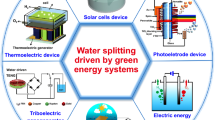Abstract
Hydrogen peroxide was produced by direct current electrolysis using only two electrodes, a carbon felt cathode and a RuO2 coated titanium anode. The required oxygen was supplied by oxidation of water and by transfer from the atmosphere or by pure oxygen injection. The current was maintained below a maximum value to avoid peroxide reduction. A high peroxide production rate was reached and a 15 mg l−1 concentration was maintained. The electrolysis removed turbidity and dissolved organic carbonaceous compounds from municipal sewage plant effluents. Real effluents were significantly disinfected owing to the direct effect of electric current and the indirect effect of peroxide. A residual effect was also observed.
Similar content being viewed by others
References
M. Doré, 'Chimie des Oxydants et Traitement des Eaux' (Lavoisier, Paris, 1989), 250 pp.
S. Guittonneau, J. de Laat, M. Doré, J.P. Duguet and C. Bonnel, Revue des Sciences de l'Eau 1 (1988) 85.
M.J. Barbier and B. Nguyen, Techniques de l'Ingénieur J1 (1996) 1.
E. Berl, Trans. Electrochem. Soc. 139 (1939) 359.
M.A. Oturan, Dépollution des eaux chargées de matières organiques toxiques-Traitement in situ par électrochimie indirecte, Journées d'Electrochimie CO 43 (1999) Toulouse.
J.A. McIntyre, Electrochem. Soc. Interface 4 (1995) 29.
R. Jolley, R. Cumming, N. Lee and L. Lewis, Wat. Sci. Tech. 14 (1982) 45.
M. Christopher and L. Richard, J. Hazardous Materials 41 (1995) 105.
'Standard Methods for the Examination of Water and Wastewater', American Public Health Association/American Water Works Association/Water Environment Federation, Washington DC (1995), 825 pp.
E. Brillas, Degradation of aromatic pollutants by advanced oxidation processes using an oxygen diffusion cathode, Journées d'Electrochimie CP 6 (1999) Toulouse.
A.H. Bannoud, F. Persin and M. Rumeau, Wat. Res. 22 (1993) 1385.
A. Kraft, M. Stadelmann, M. Blaschke, D. Kreysig, B. Sandt and F. Schröder, J. Appl. Electrochem. 29 (1999) 861.
G. Logsdon, V. Thurman and J. Stoecker, Cyst. J. Awwa. 77 (1985) 61.
A. Montiel and B. Welte, J. Fr. d'Hydrologie 21 (1990) 31.
J. Grimm, D. Bessarabov and R. Sanderson, Desalination 115 (1998) 285.
C. Comminellis, Electrochim. Acta 38 (1993) 1857.
Y.I. Matatov-Meytal and M. Sheintuch, Ind. Eng. Chem. Res. 37 (1998) 309.
R. Desjardins, 'Désinfection' (Lavoisier, Paris, 1988), 195 pp.
B. Prescott, F. Harley and L. Klein, 'Microbiologie' (De Boeck Wesmael, Brussels, 1995), 148 pp.
M. Okochi, N. Nakamura and T. Matsunaga, Electrochim. Acta 44 (1999) 3795.
V. Kovalev and M. Band, Khimiya i Tekhnologiya Vody 5 (1983) 248.
L. Barssotti and J.C. Cheftel, Sciences des Aliments 19 (1999) 3.
J.L. Pillaud, 'Application de l'Oxydation Anodique au Traitement de certains Effluents Industriels', Thèse, Université Montpellier II (1987), 202 pp.
A. Crémieux and J. Freney, Mécanisme d'action sur les bactéries et les champignons, in J. Fleurette, J. Freney and E. Reverdy (Eds), 'Antisepsie et Désinfection' (Eska, Paris, 1995), pp. 23-37.
A. Garnerone, 'Contribution à l'Etude des Mécanismes d'Action des Agents Antiseptiques dans les eaux: Application à la Désinfection Electrochimique Indirecte', Thèse, Institut National Polytechnique de Grenoble (1979), 165 pp.
O.S. Savluk, Khimiya i Tekhnologiya Vody 4 (1982) 79.
A. Crémieux, Méthode d'étude de l'activité in vitro des antiseptiques et des désinfectants sur les bactéries et champignons, in J. Fleurette, J. Freney and E. Reverdy (Eds), 'Antisepsie et Désinfection' (Eska, Paris, 1995), pp. 66-84.
Author information
Authors and Affiliations
Rights and permissions
About this article
Cite this article
Drogui, P., Elmaleh, S., Rumeau, M. et al. Hydrogen peroxide production by water electrolysis: Application to disinfection. Journal of Applied Electrochemistry 31, 877–882 (2001). https://doi.org/10.1023/A:1017588221369
Issue Date:
DOI: https://doi.org/10.1023/A:1017588221369




